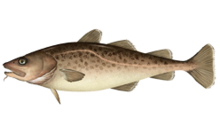Gadus macrocephalus
| Pacific cod | |
|---|---|
 |
|
| Scientific classification | |
| Kingdom: | Animalia |
| Phylum: | Chordata |
| Class: | Actinopterygii |
| Order: | Gadiformes |
| Family: | Gadidae |
| Genus: | Gadus |
| Species: | G. macrocephalus |
| Binomial name | |
|
Gadus macrocephalus Tilesius, 1810 |
|
The Pacific cod, Gadus macrocephalus, is a species of ray-finned fish in the family Gadidae. It is a bottom-dwelling fish found in the northwestern Pacific Ocean, mainly on the continental shelf and upper slopes, to depths of about 900 m (3,000 ft). It can grow to a length of a meter or so and is found in large schools. It is an important commercial food species and is also known as gray cod or grey cod, and grayfish or greyfish. Fishing for this species is regulated with quotas being allotted for hook and line fishing, pots, and bottom trawls.
It has three separate dorsal fins, and the catfish-like whiskers on its lower jaw. In appearance, it is similar to the Atlantic cod. A bottom dweller, it is found mainly along the continental shelf and upper slopes with a range around the rim of the North Pacific Ocean, from the Yellow Sea to the Bering Strait, along the Aleutian Islands, and south to about Los Angeles, down to the depths of 900 meters (~ 3000 feet). May grow up to 1 m (39") and weigh up to 15 kg (33 lbs). It is found in huge schools.
Molecular genetic analyses strongly suggest that Pacific cod and Greenland cod (Gadus ogac) from Greenland–the Arctic ocean are the same species; G. ogac is then a junior synonym of G. macrocephalus. Nevertheless, ITIS still lists Gadus ogac as a valid name. This change would greatly expand the geographic range of Pacific cod.
In the Northwest Pacific catches of Pacific cod by the United States trawl fishery and joint-venture fisheries increased from less than 1,000 tonnes in 1979 to nearly 91,000 tonnes in 1984 and reached 430,196 tonnes in 1995. Today, catches are tightly regulated and the Pacific cod quota is split among fisheries that use hook and line gear, pots, and bottom trawls.
...
Wikipedia
